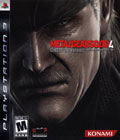Genre: Action/Adventure
Publisher: Konami
Developer: Kojima Productions
Release Date: June 12, 2008
Metal Gear Solid 4: Guns of the Patriots is a game that carries many important banners. It's the final chapter in an epic story arc that started over two decades ago and is beloved by millions. It shows an iconic hero past his prime who is still fighting his battles in the twilight hours of his life. These make the arrival of MGS4 all the more bittersweet, for as much as the game hits its stride as one of the most epic titles in recent memory, it just as often stunningly falters as a part of the video game medium. If nothing else, MGS4 is where the series implodes under its own epic proportions, ending the franchise at its lowest point.
The plot of MGS4 is the culmination of seven titles set in the Metal Gear universe chronicling the actions of Solid Snake, a man whose skills in infiltration and sheer durability are legendary. In MGS4, Snake is a considerably older man, aging prematurely due to a shortened lifespan specifically placed into his genetic code. As Snake nears the end of his days, he finds himself on the battlefield once more, tracking an enemy once thought to be dead while the world itself has been plunged into a series of proxy wars fought by private military companies (PMCs).
PMCs have become the world's dominant military force and are essentially mercenary organizations hired by nations to fight their wars for them. PMC soldiers from one of the five major companies of the world make up the bulk of the enemies that Snake faces in the game, and it will often be up to the player to guide Snake through a battlefield in which PMC and local militia solders are fighting it out. In some situations, the local militia views Snake as an ally, and in others, they view him as a threat, but the five PMCs all have orders to kill Snake on sight.
This dynamic lends itself incredibly well to the "tactical espionage action" that is the hallmark of the Metal Gear Solid series. Snake has lots of tricks up his sleeve, such as old games to help him get through an area undetected and some new items, like the Metal Gear Mk II, which is a pint-sized, cloaked, non-combat robot that can scout the situation ahead. Other new items include copies of "Playboy" magazine that can be placed on the ground to distract wandering soldiers and the Solid Eye, which can help Snake by feeding him information about his surroundings. It can be a huge rush to sneak down the middle of a battlefield undetected, knowing that participants on either side would simply gun you down should they happen upon you.
One massive boon that Snake has in his favor in MGS4 is the OctoCamo suit, which builds on the camouflage gameplay mechanic set forth in MGS3. The skin of the OctoCamo suit is much like that of a chameleons, and whenever Snake stays still in either the prone position or while hugging a wall, his suit adapts the texture and look of the area. Snake's visibility is measured on a camouflage percentage meter, which lets the player know exactly how well the camouflage is working in accordance to his movement speed, stance, and a handful of other factors. This system works well in that it lets players change their camouflage as often as they want without the need for interrupting the gameplay. In some situations, Snake can don other clothing over his suit, such as a disguise to make him look like a local militia fighter; the disguise throws off the local militia if they are hostile, and the PMCs will no longer single out Snake as a primary target on the battlefield.
When the game is played properly, the player should rarely engage in firefights, but there are times when the use of a weapon can be as much of a tool as it is an instrument of death. Regardless of whether the player intends to tranquilize, use other non-lethal rounds, or intend to outright murder someone, the handling of firearms in MGS4 is intuitive. Holding the L1 button brings the weapon up to bear, at which point pressing the R1 button fires. Pressing the Triangle button while holding L1 toggles between first- and third-person aiming, with the former using the weapon's sights or scope to line up shots.
Near the beginning of the game, Snake meets up with a man named Drebin, who is not only capable of selling guns, ammo, and accessories, but is also Snake's go-to guy for unlocking a new gun. PMC weapons are coded to only be fired by that particular PMC's soldiers, meaning that Snake must launder any guns he picks up through Drebin, who can remove the lock. Some weapons can be accessorized with silencers, grips, scopes, laser sights, and flashlights. Drebin points are the currency used in these transactions and are gained by picking up weapons that Snake already has, and they're automatically converted into a set amount of points. Points are also accumulated by performing well (getting spotted a minimum number of times, killing fewer people, etc.).
Snake has extensive training in close-quarters combat (CQC), which allows him to grab an enemy from behind to choke him or slit his throat, or use him as a human shield. Snake has a basic string of melee attacks that can knock down enemies, but it's really only useful as a last resort. While he can perform such moves either unarmed or with single-handed weapons, when he's equipped with a two-handed firearm, Snake simply shunts it forward, doing little damage but knocking the enemy off balance. Enemies who have been killed or knocked unconscious can be stuffed into lockers or dragged away and hidden so that their comrades won't happen upon them and sound the alarm.
The gameplay mechanics in MGS4 work wonderfully well, but they take a complete backseat to the presentation of cinematics and continuing the game's plot. There have been many people talking about how many cut scenes there are in the game, which thankfully can be both skipped or paused if you need a break. On our first playthrough, we watched all of cut scenes and completed the game in 13 hours, while in our second, we skipped them all and completed the game in just over four hours. It is a given point that the second's short time was partly caused by simply knowing what to do and where to go, but it does help illustrate that MGS4 is a very cut scene-heavy game.
This wouldn't be a problem if the cut scenes were not all but forcefully crammed down the player's throat at every turn. At one point in Act 3, the player can expect to watch about 1.5 hours of cut scenes with no gameplay in between, and they're only broken up by the occasional load screen and save prompt. Many cut scenes roll by at a pacing normally reserved for glaciers, with conversations flowing by at an overly leisurely pace. Cut scenes in MGS4 often make use of redundant dialogue or explain things in minute detail that essentially has little bearing on the task at hand.
The game is essentially broken up into five acts, with Acts 1 and 2 easily representing some of the best of the series. Act 3 is a monotonous sneaking section with an on-rails shooter and a boss fight, while Act 4 is a trip down memory lane that makes little use of any of the game mechanics that make the beginning of the title so enjoyable. Act 5 throws such mechanics out the window and reduces the actual gameplay to little more than a vehicle to deliver more cut scenes to the player.
However, MGS4 does have one of the best game engines crafted to date. Much of the graphics are made great thanks to artistic usage of lighting effects and filters just as often as it is due to detailed textures and environments. Sound design is particularly impressive, and with a surround sound system, it can be all too easy to become fully immersed in the environmental sounds. Weapons are satisfyingly loud to match their usual effectiveness at dispatching enemies, and enemies also have a fair amount of dialogue as they communicate with one another. Voice acting is great across the board, which is a thankful trait, given how much of it must be experienced.
There are many aspects of Metal Gear Solid 4: Guns of the Patriots that would qualify it as one of the best stealth games of all time. The flexible and creative gameplay elements are stronger than ever, backed by arguably the best engine to date for such a game. After the conclusion of Act 2, the game enters a downward spiral, becoming more of a non-interactive movie and using less of the great gameplay of which it is obviously capable. With a second half that is overloaded with cut scenes and light on the gameplay, Metal Gear Solid 4 ultimately comes across as a title that obviously puts plot first and gameplay second, which is contrary to what makes a great video game in the first place.
Score: 8.1/10
More articles about Metal Gear Solid 4: Guns of the Patriots











 MGS4: Guns of the Patriots is set in a war-torn future where huge conglomerates fight for supremacy using armies of hand-picked mercenaries. This battle-scarred arena is seen through the eyes of an older Solid Snake who has been charged with infiltrating a number of key locations across the globe, including the Middle East and South America.
MGS4: Guns of the Patriots is set in a war-torn future where huge conglomerates fight for supremacy using armies of hand-picked mercenaries. This battle-scarred arena is seen through the eyes of an older Solid Snake who has been charged with infiltrating a number of key locations across the globe, including the Middle East and South America.














